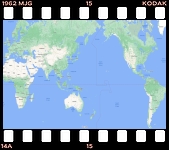I felt much better when I woke on the morning of 2nd January – no more fever – so I ordered a good breakfast. After checking out of Gringo Bill’s I got to the station to find that my ticket back to Cusco didn’t in fact include a seat. I therefore sat in the aisle on my backpack for the entire trip. Early afternoon, back in Cusco, I checked into Hostal Rojas near the historic centre. Later I went to a Hari Krishner restaurant, which seems to be popular with other backpackers, where I got talking to an Israeli called Jerome.
I then headed to the AeroPeru office. My original AeroPeru ticket included a flight from Arequipa to Juliaca, since my plan when I bought it was to go by land from Cusco to Arequipa try to see the Nazca Lines, and then fly back up to the altiplano on 5th Jan. But I have decided that Nazca is a long way off my route into Bolivia via Lake Titicaca. So I tried to get a refund or at least change the air ticket in order to fly Cusco to Juliaca, but was told that it is not changeable. So that’s the end of that. The train to Puno (on the shores of Lake Titicaca) sounds safe enough and has plenty of appeal, I so will travel overland from here on. My extra voucher will never be used…

Back at the hotel I ran into some old friends – the Israelis from La Esperanza (Yossi and Yoram), Paul (Irish) and Rachel (Kiwi) who I had last seen on the beach at Atacames on the the Ecuadorian coast. The 4 of them have been travelling together in Peru along with some others. We all ended up at a fish restaurant with delicious trout, and followed by (somewhat unexpectedly) lemon merengue pie. A Swedish girl joined us – she lamented that, like me, she has been looking for some authentic Andean folk music without success. To drown our sorrows about this, we all headed for a pub. No Andean music there either, needless to say…
In the morning I decided that my plan for the day after would be to depart (by train) directly for Puno on Lake Titicaca, rather than try to get to the Inca ruins of Pisac. I went to the station office to sort out a ticket but it was closed – there was some kind of demonstration nearby, which may have been the reason. It was still closed in the afternoon when I checked again, so I went to the travel agent (from which I had got the Machu Picchu ticket) and they sorted out a ticket to Puno for me.
I have discovered that alpaca wool is much softer (and more compressible) than llama wool, and so decided to replace the rather bulky llama pullover that I bought for the Tungurahua ascent. I had a few other things to ship back home so made the effort to make a parcel, including the llama pullover. But getting this done took forever (hours), and in the end I had to ship it air mail which cost about as much as the value of what I was sending (if not more).
Something, however, of immeasurable value that I have been sending home, is a set of photocopies of the latest pages from my diary, just in case I lose the diary (or everything gets stolen).
The tribulations of the ticket-buying and parcel-sending in Cusco were more than made up for by the beautiful old centre of the city, in which original Inca stonework is combined with Spanish colonial to create a unique look. The perfection of the Inca stonework is stunning, as it is in Machu Picchu. Irregular blocks have been worked with such precision to exactly fit together, that in most cases a thin knife blade could not be pushed between the stones.
I relaxed in the hotel later, and read a book, to be well rested. Next day’s train trip to Puno, 400 km away and at an altitude of 3850 m (12,600 feet), will be a long one…

